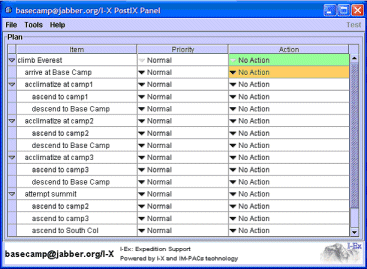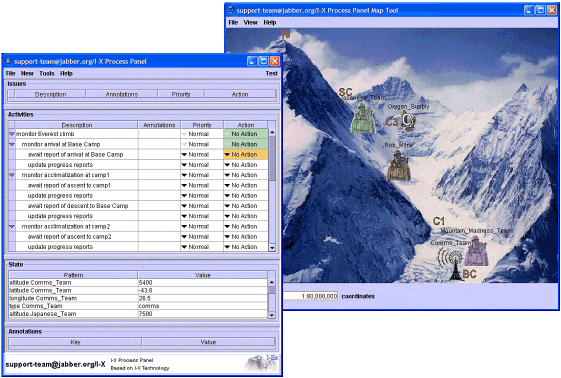I-Ex: Extreme Expedition Support
An expedition such as an attempt on Everest obviously requires a lot of coordination and planning, first during the preparatory stages, later during the expedition itself, and finally in winding-up the effort. Where previously this would primarily be done 'manually', the rise of the internet and the World-Wide Web allows the introduction of higher levels of computer support and wider access to information from a variety of sources.
The aim of the I-Ex project is to provide a means to integrate and structure the expedition activity with information from disparate sources and allow access to artificial intelligence technologies where appropriate. This support builds on the more general I-X architecture.
What is I-X?
Simply put, the purpose of
I-X is to provide computer support to people who are performing some task. This task might range from, say, designing a car to coordinating an attempt on Everest. The
I-X architecture supplies a framework that encourages a methodological approach to the task, based on cycles of issue-raising, -handling and -resolution. This is underpinned by the 'intelligent messaging' of issues, activities and other information among the agents in the system. This allows users to manipulate, transform and transmit information in context-sensitive ways that continually aim to move the process forward.
I-X's foundations in AI planning technologies allow the invocation of automated planners that are able to suggest potential ways by which to achieve task sub-goals, based on knowledge of the capabilities of other - computer or human - agents that are currently available.

I-Ex: Everest
Rob Milne's journey to the Himalaya provides us with an opportunity to show how I-Ex would apply to a real expedition. In this case, the
I-Ex infrastructure is as follows:
- The mountaineer, carrying I-X on a lightweight Pocket PC/PDA, continually reports his progress and status to the base camp reporting system.
- Progress is monitored at base camp (which has 'full' internet connectivity), and in turn supplies the mountaineer with next or revised objectives, latest weather updates, etc.
- The UK Expedition Support Team is kept informed of progress, providing a full reporting system and updating the expedition web site accordingly.
In the event of, say, a significant deterioration in weather forecast over the coming hours, the
I-X technology might be invoked to re-plan aspects of the climb. This might involve reasoning with available resources (for example, the number of oxygen bottles known to be stored at the South Col), temporal aspects (when will the bad weather pass over? how many hours of daylight are left?) and capabilities (available rescue services, if the situation worsens). The outcome would be a revised set of activities, selected using the latest available information, and designed to maximise the safety of the mountaineer.






